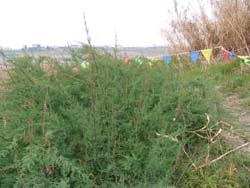

Prof. JIANG Mingxi gives an on-the-spot illustration about the newly-discovered plant.
It was some 100 kilometers away from the Three Gorges Dam down the Yangtze River that Prof. JIANG Mingxi and his colleague from the CAS Wuhan Botanical Garden saw those plants, which were found by local people a few days before. May they turn out to be the No.1 endangered species previously thought to grow only in the area that was entirely flooded upon the Reservoir's sluice?
After careful scrutiny, the experts finally said yes. It was on December 28, 2007, a frigid winter day when deciduous trees and withered flowers strewed everywhere. However, the newly discovered population blooms in riotous profusion of brisk green, the strongest individual up to about 2m in height and infant ones just sprouting from below the topsoil.
Lax-flowered False. tamarisk (
Myricaria laxiflora) was its name. Scattered on an islet amid the Yangtze River currents, they appeared as erect shrubs featuring small but dense leaves, sparse flowers as well as terminal raceme, looking exactly the same to those once lived near the giant Dam. The dispersed distribution and associated grasses imply that they are a natural and non-cultivated species, said Prof. Jiang.
The plant, an endemic species found only in China, is unique and valuable in many ways compared with its cousins in the same genus. While others eke out their survivals in saline-alkali soils or deserts around the Himalayas,
M. laxiflora enjoys the warmth and wetness on the Yangtze River's upper/mid reaches. It is the one and only species that stays foliate in winter and fresh under water for several months without being rotted, thus suitable for landscaping and soil conservation. Besides, according to WU Zhengyi, chief-editor of
Flora of China and senior CAS botanist, the plant is very likely to be the ancestor of a sister species of hers (
M. germanica) now widespread across the Mediterranean, and this fact adds a taxonomic dimension to its research significance.
As a native species of the Three Gorges area,
M. laxiflora ranks the top among endangered wildlife members inhabiting in riparian zone. Data showed they grow at 70-155m above the sea level, and their original ecological niche would have totally lost upon the Reservoir's impoundment to a height of 156m in October 2006.
The Chinese Government initiated a series of measures to preserve this valuable plant from its narrow and imperiled habitats. Between 2002 and 2007, projects were launched under the sponsorship of the Three Gorges Project Construction Committee for its urgent
ex-situ conservation. Botanists from the Beijing-based CAS Institute of Botany and the CAS Wuhan Botanical Garden worked around the clock to remove thousands of its individuals out of the submerged areas to safer places in adjacent Chongqing Municipality and Hubei Province.
Prof. Jiang headed one of such projects and has been working on saving rare and endangered plant species at the Three Gorges for over twenty consecutive years.
As a result of five-year joint efforts and with a total investment up to 2.4 million yuan, researchers finally established seven ex-situ conservation bases including Shiping Forestry Center in Chongqing, the southern beach of Yangtze-River Highway Bridge and Three Gorges Botanical Garden in Yichang City and Wuhan Botanical Garden. In all, about 7,000 plants have been rescued.
Since the first wild population of
M. laxiflora outside the Three Gorges has been brought to light, Prof. Jiang said that many previous conclusions need to be revised or re-examined. For instance, its original habitats are neither necessarily confined to the Reservoir region nor entirely devastated by the water conservancy project. GPS showed that the plant can easily survive on the islet, only at an elevation of 44m.
The discovery sheds light on some long-standing mysteries of
M. laxiflora and offers a new approach to its protection -- that is,
in-situ conservation.
Scientists have collected samples to find out more about their origin, age, genetic variation level and ecological adaptation mechanism. They also plan to carry out field investigations in nearby regions, hoping to find more wild populations of this plant.
However, the professor claimed it still too early to remove the plant from the endangered species list. On one hand, most of its habitats have already lost during the Dam's construction, and wild population was found only on simplex dwelling places like islets in the Yangtze. On the other hand, the number of individual plants is not the sole criteria to judge between an endangered or non-endangered species.
Built mainly for flood control and power generation, the Three Gorges Project boasts the largest water conservancy in the world today. Its construction was officially started in 1994, and by now the Reservoir's water surface stands at about 156m above the sea level.








